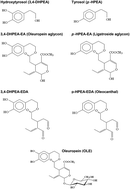Anti-cancer properties of olive oil secoiridoid phenols: a systematic review of in vivo studies
Abstract
Epidemiological studies suggest that olive oil intake is associated to a reduced risk of cancer. Recently, the chemopreventive activity of olive oil has been attributed to its unique phenolic compounds represented by phenolic alcohols, hydroxytyrosol (3,4-dihydroxyphenylethanol: 3,4-DHPEA) and tyrosol (p-hydroxyphenylethanol: p-HPEA), and their secoiridoid derivatives 3,4-DHPEA-EA (oleuropein aglycon), p-HPEA-EA (ligstroside aglycon), 3,4-DHPEA-EDA, p-HPEA-EDA (oleocanthal), and oleuropein. Several studies have demonstrated that these compounds are able to inhibit proliferation and induce apoptosis in different tumor cell lines. These in vitro effects have been recently summarized in several reviews. The aim of this systematic review was to evaluate the in vivo anti-cancer activities of secoiridoid phenols as evidenced by either animal models of carcinogenesis or human intervention trials. From the literature research through “PubMed” and “Web of Science”, 16 animal studies and 5 human intervention trials were identified and included in the review. Most of the animal studies have confirmed the ability of these compounds to inhibit the carcinogenesis process at both initiation and promotion/progression phases. All human intervention trials have investigated the effects of olive oil phenols on DNA damage. Among the five selected studies, three have shown a significant preventive effect on oxidative DNA damage in terms of reduction of 8-oxo-7,8-dihydro-2′-deoxyguanosine in urine, in mitochondria DNA of mononuclear cells and in lymphocyte DNA. The other two studies failed to see an effect on the urinary excretion of either etheno–DNA adducts or oxidation products of guanine. Further investigations are necessary to clarify the real chemopreventive potential of olive oil secoiridoid phenols on humans performing intervention studies on populations at high cancer risk.


 Please wait while we load your content...
Please wait while we load your content...